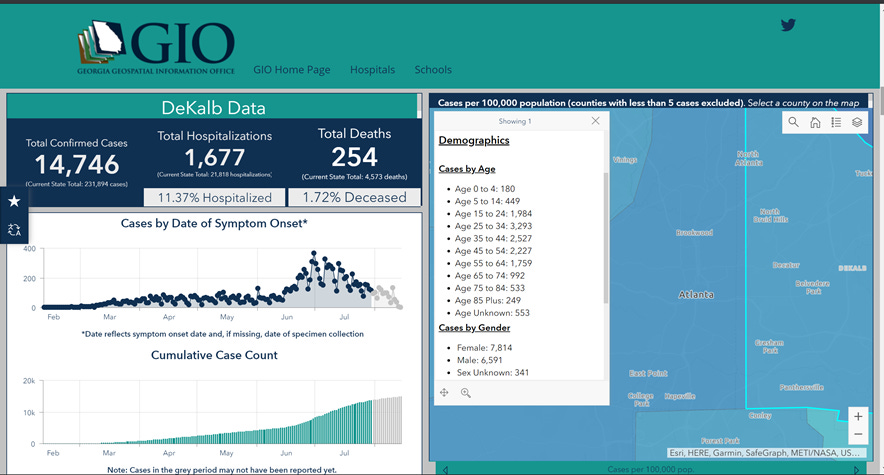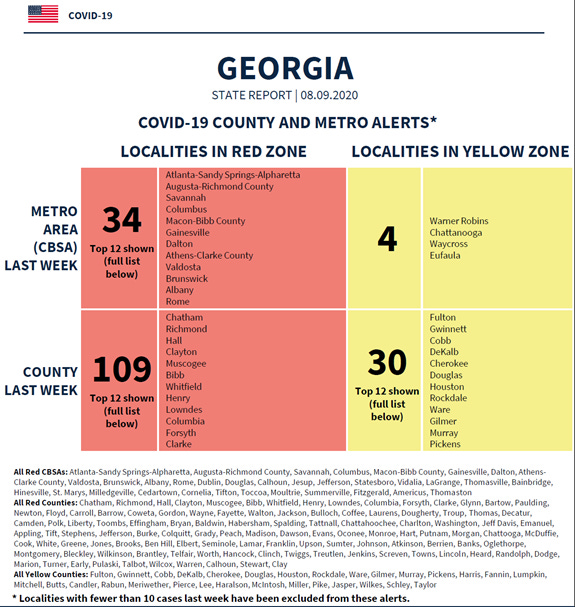We made it to another Friday! I hope everyone has a fun, socially distanced weekend.
It is a really busy news day for Georgia and the COVID-19 pandemic. I don’t have time, probably, to address all of these things. But here’s some reading for you to consider:
The Atlanta Journal Constitution released the White House Coronavirus Task Force’s latest assessment of Georgia. It is just the report for Georgia. I have not yet seen the report for all the states and territories. If that becomes available I will update this posting.
A second AJC report indicates that state agencies are not being forthcoming with open records request information and are redacting documents that perhaps shouldn’t be redacted.
The Governor’s press office issued a press release to the media with a very optimistic assessment of where things are currently for Georgia, perhaps in response to the White House report. However, here is their helpful link to tweet the report.
Starting with the White House Coronavirus Task Force’s report on Georgia: it seems pretty dark.
We are in the red zone for cases
Our new case rate per population is 1.9 times the national average.
Between August 1 - 7, on average 305 patients with confirmed COVID-19 and 356 patients suspected as having COVID-19 were newly admitted each day. But they are only getting consistent reporting from 81% of Georgia’s hospitals…so it is likely an undercount.
They indicate that current mitigation efforts are not making a sufficient impact and strongly recommend a statewide mask mandate. Further, they recommend limiting social gatherings to 10 people or less (what does this mean for schools, then?).
Require every university with RNA detection platforms (capable of performing the PCR test) to use this equipment to expand surveillance testing for schools (K-12, community colleges) and university students.

SNF stands for skilled nursing facility. *Indicates absolute change in percentage points. **Due to delayed reporting, this figure may underestimate total diagnostic tests and week-on-week changes in diagnostic tests.
We are doing half of the national average for testing output. Of the tests we are doing, our percent positive rate is 1.8 times higher than the national average. Our death rate is also above the national average. Finally, our state has a rate of disease within skilled nursing facilities that is 1.9 times the national average.
They also determined that we had 34 metro areas in the red zone and four in the yellow zone. They still seem to think Chattanooga is in Georgia, but maybe this is to alert people along the northern border.
Here’s what it means to be in the red zone.

Finally, here’s how Georgia’s testing and disease transmission problems compare to the rest of the country:

Considering that the President and the Governor are from the same political party, these recommendations do not seem partisan. Instead, they are science-driven. And as we try to cope with this scientific problem, we desperately need science-driven solutions.
Next, the Governor’s press release based on the same data that the White House Task Coronavirus Task Force had to make their assessment. Here is what I shared with media outlets who asked for my comments, especially since the two analyses were so different:
The White House Coronavirus Task Force indicates that Georgia is in the red zone for both new cases and test positivity. Our new case rate is 1.9 times higher (almost twice) the national average. The Governor is counting percent positivity rate as a success when we haven't been close to meeting the WHO guidance for testing (<5% positive for 14 days) since mid-June. In addition, what good is averaging nearly 31,000 tests per day if those tests are taking 2-3 weeks to be performed and reported? Curiously, there is no mention of the turnaround time for tests in the Governor's report. Meanwhile, we are seeing more and more cases backdated outside of the 14-day window, indicating that the decline in cases that he's citing is an artifact of testing backlogs. Our deficiencies in testing combined with our lack of sufficient workforce for contact tracing make it impossible to contain the spread of this virus. If we cannot build and sustain sufficient capacity for testing and contact tracing, then we need to bring community disease transmission back to manageable levels to accommodate our testing and tracing capacity.
It is noteworthy that the second highest origin of outbreak clusters in the Governor's report are schools and school athletic teams. These outbreaks were predicted to happen due to widespread community transmission. I hope that this proves to be an important data point to other school systems who are weighing when to return to face to face instruction.There is a very stark difference in the way that the White House Coronavirus Task Force sees the current situation compared to our Governor. I think we all value optimism but not when we are witnessing so many preventable deaths...deaths that warrant no mention whatsoever in the Governor's report. We need greater action to limit the transmission of the virus and the White House Coronavirus Task Force also shares that concern.
The AJC article from today detailing some of their struggles with gaining access to critical information for the pandemic response at the state level is troubling for several reasons. But from a data perspective, I suppose I would say that if the facts are on the Governor’s side, as he says they are, then why would he not want Georgia to see them? Why do people have to file open record requests for the percent positive rate for their county? Why did I have to do so to ensure that the same data was available to all 159 counties in Georgia?
On to today’s update on Georgia data.
Testing
There were 27,443 new test results reported today, a below average day. Of those, 10.9% were positive. We remain above the 5% guidance from the World Health Organization for containing the virus.

Of the 3227 net increase in cases reported today, 756 (23.4%) were backdated prior to the 14-day window.
Cases
There was a net increase of 3227 newly identified cases today compared to yesterday’s total. The new statewide total is 231,895. Thirty-nine percent of today’s newly identified cases came from nonrural counties that aren’t part of the Atlanta metro. The next largest category was rural counties with 27.6% of the new cases. In summary two thirds of today’s cases came from outside the Atlanta metro.
Earlier today I sent out a list of resources that I trust for evaluating COVID data. One of them is a hub of information at the Georgia Geospatial Information Office (they’re the mapping folks!) and it is chock full of data at a county level, including demographic data of the cases within that county. I have DeKalb pulled up in the screenshot below. But you can see how cases are distributed by age group, gender, race, etc.

When looking at statewide cases by date of symptom onset, it looks like the cases are on the decline, but I think evidence of excessive backdating prior to the 14-day window (cited above) indicates that it is too soon to tell whether this decline is real or an artifact of the testing backlogs that have plagued Georgia since the case surge began. By date of report, cases have plateaued. Since that method of graphing is heavily impacted by testing output, it’s possible that it’s more a sign that our testing output has plateaued rather than that cases have plateaued.
Hospitalizations
According to the Georgia Emergency Management Agency, current hospitalizations declined by 116 patients overnight. Let’s hope that trend continues. Let’s also hope that means good things for bed capacity.

Deaths
Sadly, there is another pediatric death to report. This time it is a 15-year old boy from Gwinnett county with no underlying conditions. That makes three in total so far.

The boy from Gwinnett county is just one of 35 deaths reported today (net increase compared to yesterday’s totals). Half of the state’s newly reported deaths came from nonrural counties outside of the Atlanta metro. The new statewide total is 4573.
Our deaths by date of death now surpass our previous peak that we saw in April-May. Right now it appears that deaths are on the decline. Let’s hope that trend continues.

That’s it for today. Take care!
References
https://www.ajc.com/news/white-house-warns-of-widespread-and-expanding-viral-spread-in-georgia/5DEVU3BSCZAIHCSI3A3KTTGGIY/?fbclid=IwAR2COsoE9FYHQxnP8xZQ-7IImVU42u__DhPNvJ3_syuUTaIIyPjgwX-8vG0
https://www.ajc.com/politics/georgia-keeps-key-virus-information-from-public/DHZGBAGKJRFLVDCGCWGJ2NGCLE/?fbclid=IwAR31eEDA5n7453J_cFZqTGPZGhfWyurz76_KP9K-6HyOsj2EdmlNM4NQoZk
https://madmimi.com/p/3077211?pact=1082386-159624032-12607200055-26faffe600d632fb7b61f1c7ecc0fbb57e7d2045&twitter_share=true#
https://amberschmidtkephd.substack.com/p/pcr-percent-positive-rate-by-county
http://208.97.140.204:8080/epicurveInteractive-cases.html



